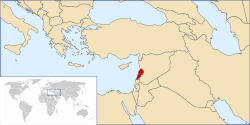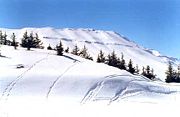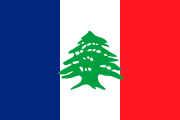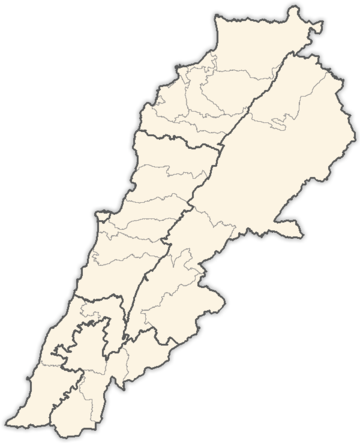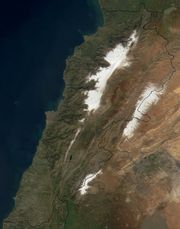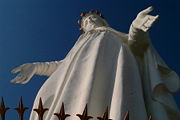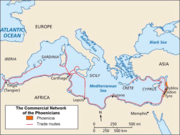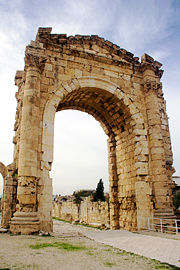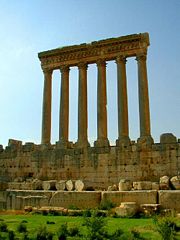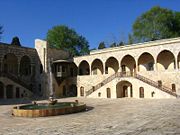Lebanon
2008/9 Schools Wikipedia Selection. Related subjects: Middle Eastern Countries
| الجمهورية اللبنانية Al-Jumhūrīyyah al-Lubnānīyyah Lebanese Republic |
||||||
|---|---|---|---|---|---|---|
|
||||||
| Anthem: Kulluna lil-watan lil 'ula lil-'alam |
||||||
|
|
||||||
| Capital (and largest city) |
Beirut |
|||||
| Official languages | Arabic | |||||
| Other common languages | French, English, Armenian | |||||
| Demonym | Lebanese | |||||
| Government | Confessionalist, Parliamentary democracy |
|||||
| - | President | Michel Suleiman | ||||
| - | Prime Minister | Fouad Siniora | ||||
| - | Speaker of Parliament | Nabih Berri | ||||
| Independence | from French-administered League of Nations mandate | |||||
| - | Declared | 26 November 1941 | ||||
| - | Recognized | 22 November 1943 | ||||
| Area | ||||||
| - | Total | 10,452 km² ( 166th) 4,035 sq mi |
||||
| - | Water (%) | 1.6 | ||||
| Population | ||||||
| - | February 2008 estimate | 4,196,453 ( 125th) | ||||
| - | Density | 358/km² ( 26th) 948/sq mi |
||||
| GDP ( PPP) | 2007 estimate | |||||
| - | Total | $42.27 billion ( 84th) | ||||
| - | Per capita | $11,300 ( 42nd) | ||||
| HDI (2007) | 0.772 (medium) ( 88th) | |||||
| Currency | Lebanese pound ( LBP) |
|||||
| Time zone | EET ( UTC+2) | |||||
| - | Summer ( DST) | EEST ( UTC+3) | ||||
| Internet TLD | .lb | |||||
| Calling code | +961 | |||||
Lebanon (IPA: /ˈlɛbənɒn/ Arabic: لبنان Lubnān), officially the Republic of Lebanon or Lebanese Republic (الجمهورية اللبنانية), is country in Western Asia, on the eastern shore of the Mediterranean Sea. It is bordered by Syria to the north and east, and Israel to the south. It is close to Cyprus through the Mediterranean Sea. Due to its sectarian diversity, Lebanon evolved in 1943 a unique political system, known as confessionalism, based on a community-based power-sharing mechanism. It was created when the ruling French mandatory powers expanded the borders of the former autonomous Ottoman Mount Lebanon district that was mostly populated by Maronite Christians and Druze.
Lebanon is the historic home of the Phoenicians, a maritime culture which flourished for more than 2,000 years (2700-450 B.C.). Following the collapse of the Ottoman Empire after World War I, the five provinces that comprise present-day Lebanon were mandated to France. The country gained independence in 1943, and French troops withdrew in 1946.
Before the Lebanese Civil War (1975-1990), the country enjoyed a period of relative calm and prosperity, driven by the tourism, agriculture, and banking sectors of the economy. It is considered the banking capital of the Levant and was widely known as the "Switzerland of the East" due to its financial power and diversity. Lebanon also attracted large numbers of tourists to the point that the capital Beirut became widely referred to as the "Paris of the East." Immediately following the end of the war, there were extensive efforts to revive the economy and rebuild national infrastructure.
Before July 2006, a considerable degree of stability had been achieved throughout much of the country, Beirut's reconstruction was almost complete, and an increasing number of foreign tourists were pouring into Lebanon's resorts. This was until the one month long 2006 Lebanon War with Israel which caused significant civilian loss of life and serious damage to Lebanon's civil infrastructure. The conflict lasted from 12 July 2006 until a cessation of hostilities call, by the UN Security Council, went into effect on 14 August 2006.
Etymology
The name Lebanon ("Lubnān" in standard Arabic; "Libnén" in the local dialect) comes from the Canaanite (and common West Semitic) root "LBN", meaning "white", which could be regarded as a reference to the snow-capped Mount Lebanon. Occurrences of the name have been found in three of the twelve tablets of the Epic of Gilgamesh (2900 BC), the texts of the library of Ebla (2400 BC), and 71 times in the Old Testament. The name is recorded in Ancient Egyptian as Rmnn, where r stood for Canaanite l.
History
| History of the Levant |
|---|
| Stone Age |
| Kebaran · Natufian culture Halafian culture · Jericho |
| Ancient history |
| Sumerians · Ebla · Akkadian Empire Canaan · Phoenicians · Amorites Aramaeans · Edomites · Hittites Nabataeans · Palmyra · Philistines Israel and Judah Assyrian Empire · Babylonian Empire Persian Empire · Seleucid Empire Hasmonean kingdom Roman Empire · Byzantine Empire |
| Middle Ages |
| Rashidun · Umayyads Abbasids · Fatimids Crusades · Ayyubids · Mamluks |
| Modern history |
| Ottoman Empire British Mandate of Palestine Syria · Lebanon · Jordan · Iraq Israel · Palestinian territories |
|
|
Ancient history
The earliest known settlements in Lebanon date back to earlier than 5000 BC. Archaeologists have discovered in Byblos, which is considered to be one of the oldest continuously-inhabited cities in the world, remnants of prehistoric huts with crushed limestone floors, primitive weapons, and burial jars which are evidence of the Neolithic and Chalcolithic fishing communities who lived on the shore of the Mediterranean Sea over 7,000 years ago.
Lebanon was the homeland of the Phoenicians, a seafaring people that spread across the Mediterranean before the rise of Cyrus the Great. After two centuries of Persian rule, Macedonian ruler Alexander the Great attacked and burned Tyre, the most prominent Phoenician city. Throughout the subsequent centuries leading up to recent times, the country became part of numerous succeeding empires, among them Persian, Armenian, Assyrian, Macedonian, Roman, Byzantine, Arab, Crusader, and Ottoman.
French mandate and independence
Lebanon was part of the Ottoman Empire for over 400 years, in a region known as Greater Syria, , (not related to the country Syria), until 1918 when the area became a part of the French Mandate of Syria following World War I. On 1 September 1920, France formed the State of Greater Lebanon as one of several ethnic enclaves within Syria. Lebanon was a largely Christian (mainly Maronite) enclave but also included areas containing many Muslims and Druzes. On 1 September 1926, France formed the Lebanese Republic. The Republic was afterward a separate entity from Syria but still administered under the French Mandate of Syria. Lebanon gained independence in 1943, while France was occupied by Germany. General Henri Dentz, the Vichy High Commissioner for Syria and Lebanon, played a major role in the independence of the nation. The Vichy authorities in 1941 allowed Germany to move aircraft and supplies through Syria to Iraq where they were used against British forces. The United Kingdom, fearing that Nazi Germany would gain full control of Lebanon and Syria by pressure on the weak Vichy government, sent its army into Syria and Lebanon.
After the fighting ended in Lebanon, General Charles de Gaulle visited the area. Under various political pressures from both inside and outside Lebanon, de Gaulle decided to recognize the independence of Lebanon. On 26 November 1941 General Georges Catroux announced that Lebanon would become independent under the authority of the Free French government. Elections were held in 1943 and on 8 November 1943 the new Lebanese government unilaterally abolished the mandate. The French reacted by throwing the new government into prison. In the face of international pressure, the French released the government officials on 22 November 1943 and accepted the independence of Lebanon.
The allies kept the region under control until the end of World War II. The last French troops withdrew in 1946. Lebanon's unwritten National Pact of 1943 required that its president be Christian and its prime minister be Muslim.
Lebanon's history since independence has been marked by alternating periods of political stability and turmoil (including a civil conflict in 1958) interspersed with prosperity built on Beirut's position as a regional centre for finance and trade.
1948 Arab-Israeli war
Five years after gaining independence, Lebanon joined the Arab League, although Lebanon is considered as Arab by culture and not by race according to findings by the Genographic Project of the National Geographic Society, to defend Palestine shortly after the declaration of independence of Israel. during the 1948 Arab-Israeli War. It took over logistical support of the Arab Liberation Army after it found itself cut off from its bases in Syria while going on an attack on the newly-proclaimed Jewish State. The Lebanese army gained nothing during the war, and the Israeli army managed to conquer territory west of the Naphtali Mountains. After the defeat of the Arab Liberation Army in Operation Hiram, Lebanon accepted an armistice with Israel on 23 March 1949 and the conquered territory was returned. During the war, about 100,000 Palestinian refugees fled to Lebanon.
Civil war and beyond
In 1975, civil war broke out in Lebanon. The Lebanese Civil War lasted fifteen years, devastating the country's economy, and resulting in the massive loss of human life and property. It is estimated that 150,000 people were killed and another 200,000 maimed. The war ended in 1990 with the signing of the Taif Agreement and parts of Lebanon were left in ruins.
During the civil war, the Palestine Liberation Organization (PLO) used Lebanon to launch attacks against Israel. Lebanon was twice invaded and occupied by the Israel Defense Forces (IDF) in 1978 and 1982, with the PLO expelled in the second invasion. Israel remained in control of Southern Lebanon until 2000, when there was a general decision, led by Israeli Prime Minister Ehud Barak, to withdraw due to continuous guerrilla attacks executed by Hezbollah militants and a belief that Hezbollah activity would diminish and dissolve without the Israeli presence. The UN determined that the withdrawal of Israeli troops beyond the blue line was in accordance with UN Security Council Resolution 425, although a border region called the Shebaa Farms is still disputed. Hezbollah declared that it would not stop its operations against Israel until this area was liberated.
Recent history
On 14 February 2005, former Prime Minister Rafik Hariri was assassinated in a car bomb explosion near the Saint George Bay in Beirut. Leaders of the March 14 Alliance accused Syria of the attack due to its extensive military and intelligence presence in Lebanon, and the public rift between Hariri and Damascus over the Syrian-backed constitutional amendment extending pro-Syrian President Lahoud's term in office. Others, namely the March 8 Alliance and Syrian officials, claimed that the assassination may have been executed by the Israeli Mossad in an attempt to destabilize the country.
This incident triggered a series of demonstrations, known as Cedar Revolution, that demanded the withdrawal of Syrian troops from Lebanon and the establishment of an international commission to investigate the assassination. The United Nations Security Council unanimously adopted Resolution 1595 on 7 April 2005, which called for an investigation into the assassination of Rafik Hariri. The findings of the investigation were officially published on 20 October 2005 in the Mehlis report. Eventually, and under pressure from the West, Syria began withdrawing its 15,000-strong army troops from Lebanon. By 26 April 2005, all uniformed Syrian soldiers had already crossed the border back to Syria. The Hariri assassination marked the beginning of a series of assassination attempts that led to the loss of many prominent Lebanese figures.
Economic progress was halted on 12 July 2006, when the conflict, known in Lebanon as the July War began. Hezbollah captured two Israeli soldiers ( Ehud Goldwasser and Eldad Regev) during a diversionary rocket attack. In response to the detentions of the two men the IDF attacked Lebanon with intense airstrikes and artillery fire alongside ground incursions by Israeli forces. The month long conflict caused significant civilian loss of life and serious damage to Lebanon's civil infrastructure (including Beirut's airport). The conflict lasted from 12 July 2006 until 14 August when the United Nations Security Council issued resolution 1701 ordering Israeli to cease hostilities. the country's economy is still struggling to recover.
In October 2007, Émile Lahoud finished his second term as president. The opposition conditioned its vote for a successor on a power-sharing deal, thus leaving the country without a president for over 6 months.
On 9 May 2008, Hezbollah and Amal militants, in an armed attack triggered by a government decision on Hezbollah's communications network, temporarily took over Western Beirut. The situation was described by the government as an attempted coup and led many to fear the country was on the brink of civil war.
On 21 May 2008, all major Lebanese parties signed an accord to elect Michel Suleiman as President, to form a national unity government with 11 out of 30 seats for the opposition, thus enabling it to veto decisions, and to adopt a new electoral law, based on the 1960 law with amendments for the three Beirut constituencies. The deal was brokered by an Arab League delegation, headed by the Emir and Foreign Minister of Qatar and the Secretary General of the Arab League, after five days of intense negotiations in Doha. Suleiman was officially elected president on 25 May 2008.
Government and politics
Lebanon is a parliamentary democratic republic, which implements a special system known as confessionalism. This system is intended to ensure that sectarian conflict is kept at bay and attempts to fairly represent the demographic distribution of the 18 recognized religious groups in the governing body. As such, high-ranking offices are reserved for members of specific religious groups. The President, for example, has to be a Maronite Catholic Christian, the Prime Minister a Sunni Muslim and the Speaker of the Parliament a Shi’a Muslim.
Lebanon's national legislature is the unicameral Parliament of Lebanon. Its 128 seats are divided equally between Muslims and Christians, proportionately between the different denominations and proportionately between regions. Prior to 1990, the ratio stood at 6:5 in favour of Christians; however, the Taif Accord, which put an end to the 1975-1990 civil war, adjusted the ratio to grant equal representation to followers of the two religions. . The Parliament is elected for a four-year term by universal suffrage although the civil war precluded the exercise of this right.
The executive branch constitute of the President, the head of state, and the Prime Minister, the head of government. The parliament elects the president for a non-renewable six-year term by a two-third majority. The president appoints the Prime Minister. Following consultations with the parliament and the President, the Prime Minister forms the Cabinet, which must also adhere to the sectarian distribution set out by confessionalism.
Lebanon's judicial system is a mixture of Ottoman law, Napoleonic code, canon law and civil law. The Lebanese court system consists of three levels: courts of first instance, courts of appeal, and the court of cassation. The Constitutional Council rules on constitutionality of laws and electoral frauds. There also is a system of religious courts having jurisdiction over personal status matters within their own communities, with rules on matters such as marriage and inheritance.
Foreign Relations
Lebanon concluded negotiations on an association agreement with the European Union in late 2001, and both sides initialed the accord in January 2002. Lebanon also has bilateral trade agreements with several Arab states and is working toward accession to the World Trade Organization. Aside from Syria, Lebanon enjoys good relations with virtually all of the other Arab countries (despite historic tensions with Libya, the Palestinians, and Iraq), and hosted an Arab League Summit in March 2002 for the first time in more than 35 years. Lebanon is a member of the Francophone countries and hosted the Francophone Summit in October 2002.
Governorates and districts
Lebanon is divided into six governorates (mohaafazaat, Arabic: محافظات —singular mohafazah, Arabic: محافظة) which are further subdivided into twenty-five districts (aqdya—singular: qadaa). The districts themselves are also divided into several municipalities, each enclosing a group of cities or villages. The governorates and their respective districts are listed below:
Danniyeh
Lebanon
Beqaa
Jbeil
| Beirut Governorate The Beirut Governorate is not divided into districts and is limited to the city of Beirut. |
Nabatiyeh Governorate (Jabal Amel) - 4 districts
|
Beqaa Governorate - 5 districts
|
North Governorate (al-Shamal) - 7 districts
|
Mount Lebanon Governorate (Jabal Lubnan) - 6 districts
|
South Governorate (al-Janoub) - 3 districts
|
Geography and climate
Lebanon is located in Western Asia. It is bordered by the Mediterranean Sea to the west along a 225-kilometre (140 mi) coastline, by Syria to the east and north, and by Israel to the south. The Lebanon-Syria border stretches for 375 kilometres (233 mi) and the Lebanon-Israel border for 79 kilometres (49 mi). The border with the Israeli-occupied Golan Heights in Syria is disputed by Lebanon in a small area called Shebaa Farms, but the border has been demarcated by the United Nations.
Most of Lebanon's area is mountainous terrain, except for the narrow coastline and the Beqaa Valley, which plays an integral role in Lebanon's agriculture.
Lebanon has a moderate Mediterranean climate. In coastal areas, winters are generally cool and rainy whilst summers are hot and humid. In more elevated areas, temperatures usually drop below freezing during the winter with frequent, sometimes heavy snow; summers are warm and dry. Although most of Lebanon receives a relatively large amount of rainfall annually (compared to its arid surroundings), certain areas in north-eastern Lebanon receive little due to the high peaks of the western mountain front blocking much of the rain clouds that originate over the Mediterranean Sea.
In ancient times, Lebanon housed large forests of the Cedars of Lebanon, which now serve as the country's national emblem. However, centuries of trading cedar trees, used by mariners for boats, and the absence of any efforts to replant them have depleted the country's once-flourishing cedar forests.
Economy
 Economy of Lebanon |
|||
| Tourism | |||
| Agriculture | |||
| Beirut Stock Exchange | |||
| Companies listed on BSE | |||
| Companies | |||
| Bank of Lebanon | |||
| Shipping | |||
| Topics of Lebanon | |||
| Culture - Geography | |||
| History - Politics | |||
The urban population in Lebanon is noted for its commercial enterprise. Over the course of time, emigration has yielded Lebanese "commercial networks" throughout the world. Lebanon has a high proportion of skilled labor comparable to most European nations and the highest among Arabic speaking countries.
Although Lebanon is ideally suited for agricultural activities in terms of water availability and soil fertility, as it possesses the highest proportion of cultivable land in the Arabic speaking world, it does not have a large agricultural sector. Attracting a mere 12% of the total workforce, agriculture is the least popular economic sector in Lebanon. It contributes approximately 11.7% of the country's GDP, also placing it in the lowest rank compared to other economic sectors. Major produce includes apples, peaches, oranges, and lemons.
Lebanon's lack of raw materials for industry and its complete dependency on Arab countries for oil have made it difficult for the Lebanese to engage in significant industrial activity. As such, industry in Lebanon is mainly limited to small businesses concerned with reassembling and packaging imported parts. In 2004, industry ranked second in workforce, with 26% of the Lebanese working population, and second in GDP contribution, with 21% of Lebanon's GDP.

A combination of beautiful climate, many historic landmarks and World Heritage Sites continues to attract large numbers of tourists to Lebanon annually, in spite of its political instability. In addition, Lebanon's strict financial secrecy and capitalist economy—unique in its area—have given it significant economic status among Arab countries. The thriving tourism and banking activities have naturally made the services sector the most important pillar of the Lebanese economy. The majority of the Lebanese workforce (nearly 65%) take employment in the services sector as a result of abundant job opportunities and large paychecks. The GDP contribution, accordingly, is very large and amounts to roughly 67.3% of the annual Lebanese GDP.
The economy's dependence on services has always been an issue of great criticism and concern, as it leaves the country subject to the instability of this sector and the vagaries of international trade.
The 1975-1990 civil war seriously damaged Lebanon's economic infrastructure, cut national output by half, and all but ended Lebanon's position as a West Asian entrepôt and banking hub. The subsequent period of relative peace enabled the central government to restore control in Beirut, begin collecting taxes, and regain access to key port and government facilities. Economic recovery has been helped by a financially sound banking system and resilient small- and medium-scale manufacturers, with family remittances, banking services, manufactured and farm exports, and international aid as the main sources of foreign exchange.
Until the 2006 Lebanon War, Lebanon's economy witnessed excellent growth, with bank assets reaching over 75 billion US dollars. By the end of the first half of 2006, the influx of tourists to Lebanon had already registered a 49.3% increase over 2005 figures. Market capitalization was also at an all time high, estimated at $10.9 billion at the end of the second quarter of 2006, just weeks before the fighting started.
The war severely damaged Lebanon's fragile economy, especially the tourism sector. According to a preliminary report published by the Lebanese Ministry of Finance on 30 August 2006, a major economic decline was expected as a result of the fighting.
Beirut's airport, Rafiq Hariri International Airport, re-opened in September 2006 and the efforts to revive the Lebanese economy have since been proceeding at a slow pace. Major contributors to the reconstruction of Lebanon include Saudi Arabia (with US$ 1.5 billion pledged), the European Union (with about $1 billion) and a few other Gulf countries with contributions of up to $800 million.
Education
Schools
All Lebanese schools are required to follow a prescribed curriculum designed by the Ministry of Education. Private schools, approximately 1,400 in all, may also add more courses to their curriculum with approval from the Ministry of Education. The main subjects taught are mathematics, sciences, history, civics, geography, Arabic, and at least one secondary language (either French or English). The subjects gradually increase in difficulty and in number. Students in Grade 11, for example, study up to eighteen different subjects.
The government introduces a mild form of selectivity into the curriculum by giving 11th graders choice between two "concentrations": sciences, humanities, and 12th graders choose between four concentrations: life sciences, general sciences, sociology and economics, and humanities and literature. The choices in concentration do not include major changes in the number of subjects taken (if at all). However, subjects that fall out of the concentration are given less weight in grading and are less rigorous, while subjects that fall within the concentration are more challenging and contribute significantly to the final grade.
Students go through three academic phases:
- Elementary: Six years.
- Intermediate: Three years; students earn Intermediate Certification (Lebanese Brevet) at completion.
- Secondary: three years, students who pass official exams earn a Baccalaureate Certificate (Baccalauréat Libanais) in the concentration they chose in 12th grade. Students studying at French-system schools may also graduate with a French Baccalaureate that is considered equivalent to the Lebanese Baccalaureate.
These three phases are provided free to all students and the first eight years are, by law, compulsory. Nevertheless, this requirement currently falls short of being fully enforced.
Higher education
Following secondary school, Lebanese students may choose to study at a university, a college, or a vocational training institute. The number of years to complete each program varies. While the Lebanese educational system offer a very high quality and international class of education, the local employment market lacks of enough opportunities, thus encouraging many of the young educated to travel abroad.
Lebanon has forty-one nationally-accredited universities, several of which are internationally recognized. The American University of Beirut (AUB) and the Université Saint-Joseph (USJ) were the first Anglophone and the first Francophone universities to open in Lebanon, respectively. The universities, both public and private, largely operate in French or English.
At the English universities, students who have graduated from an American-style high school program enter at the freshman level to earn their baccalaureate equivalence from the Lebanese Ministry of Higher Education. This qualifies them to continue studying at the higher levels. Such students are required to have already taken the SAT I and the SAT II upon applying to college, in lieu of the official exams. On the other hand, students who have graduated from a school that follows the Lebanese educational system are directly admitted to the sophomore year. These students are still required to take the SAT I, but not the SAT II. The university academic degrees for the first stage are the Bachelor or the Licence, for the second stage are the Master or the DEA and the third stage is the doctorate.
The United Nations assigned Lebanon an education index of 0.84 in 2005.
Demographics and religion
No official census has been taken since 1932, reflecting the political sensitivity in Lebanon over confessional (i.e. religious) balance. The CIA World Fact Book gives the following distribution: Muslim - 59.7% (Shi'a, Sunni, Druze, Isma'ilite, Alawite or Nusayri), Christian - 39% (Maronite Catholic, Greek Orthodox, Melkite Catholic, Armenian Orthodox, Syriac Catholic, Armenian Catholic, Syriac Orthodox, Roman Catholic, Chaldean, Assyrian, Coptic, Protestant), other 1.3% including the "Israelite sect" (official name), basically the members of the Lebanese Jewish community.

There are 17 religious sects recognized.. An 18th sect, the Copts was added recently to make the total official religious sects in Lebanon 18. Some followers of the Druze religion do not consider themselves to be Muslim; however, the state legally recognizes Druze followers as Muslim.
The number of those inhabiting Lebanon proper was estimated at 3,925,502 in July 2007. There are approximately 18 million people of Lebanese descent spread all over the world, with Brazil having the largest Lebanese community abroad (8 million). Argentina, Australia, Canada, Colombia, Ecuador, Chile, Sweden, United Arab Emirates, Saudi Arabia, Kuwait, France, Spain, Germany, Great Britain, Mexico, Venezuela, USA, West Africa, South Africa, Congo, Haiti, and the Dominican Republic also have large and considerable Lebanese communities.
In 2007, Lebanon hosted a population of refugees and asylum seekers numbering approximately 325,800. 270,800 refugees and asylum seekers were from Palestine, 50,200 from Iraq, and 4,500 from Sudan. Lebanon forcibly returned more than 300 refugees and asylum seekers in 2007.
Language
Article 11 of Lebanon's Constitution states that "Arabic is the official national language. A law determines the cases in which the French language may be used". The majority of Lebanese people speak Arabic and either French or English fluently. Moreover, Lebanese people of Armenian or Greek descent also speak Armenian or Greek fluently. Also in use is Kurdish spoken by some of the Kurdish minorities in Lebanon, and Syriac by the Syriac minorities.
The colloquial language used in Lebanon, which is known as Lebanese, is one part of a grouping of dialects called Levantine Arabic. It differs from the literary Modern Standard Arabic, owing its historical blend to Phoenician, Aramaic, Syriac, Arabic, Turkish, and Persian. In recent years, it has become increasingly common for Lebanese people, especially the better educated, to converse in a combination of Lebanese, English and French, whereby the same sentence would include words or expressions from the different languages. In the 1960s Lebanese linguists proposed 37 letters for the Lebanese dialect based on the Latin alphabets. The Arab League rejected the idea, putting pressure on the Lebanese government to refuse such a project. Lebanese Arabic is a "language continuum"; teams of linguists have agreed that 45% of the Lebanese vocabulary is of Aramaic or Syriac origins.
In the Christian communities, until the Lebanese Civil War, it was seen as a mark of status not to speak Arabic. The reason for this is that Christians generally do not relate to Arabs or their language, and many of them consider it as an imposed language, which overran their own Syriac language ( Western Aramaic).
Culture
Overview
The area including modern Lebanon has been home to various civilizations and cultures for thousands of years. Originally home to the Phoenicians, and then subsequently conquered and occupied by the Assyrians, the Persians, the Greeks, the Romans, the Arabs, the Crusaders, the Ottoman Turks and most recently the French, Lebanese culture has over the millennia evolved by borrowing from all of these groups. Lebanon's diverse population, composed of different ethnic and religious groups, has further contributed to the country's festivals, musical styles and literature as well as cuisine, and numerous violent clashes amongst different religious and ethnic groups. When compared to the rest of the Western Asia, Lebanese society as a whole is well educated, and as of 2003 87.4% of the population was literate. Lebanese society is very modern and similar to certain cultures of Mediterranean Europe. It is often considered to serve as Europe's gateway to Western Asia as well as the Asian gateway to the Western World.
Creative arts
Lebanese music is known around the world for its soothing rhythms and oriental beats. Traditional and folk music are extremely popular as are western rhythms.
One of the most well-known Lebanese singers is Fairuz; her songs are broadcast every morning on most radio stations and many TV channels, both in Lebanon and the Arab world in general. Other prominent artists include Julia Boutros, composer and oud player Marcel Khalife, Majida El Roumi, Sabah, Wadih El Safi, and the important nun and singer Sister Marie Keyrouz, founder of The Ensemble of the Peace.
Some Lebanese artists, such as Najwa Karam and Assi Hellani, remain loyal to a traditional type of music known as 'jabali' ("from the mountains"), while other artists incorporate Western styles into their songs. Lebanese performers are among the most popular in the Arab world alongside Egyptian artists, and the star scene includes prominent figures like Najwa Karam, Nancy Ajram, Elissa (singer), Ragheb Alame, Myriam Fares, Wael Kfoury, Nawal al Zoghbi, Carole Samaha, Julia Boutros, Marwan Khouri, Waleed Tawfeek, Amal Hijazi and Majida El Roumi.
Sports
Because of Lebanon's unique geography, both summer and winter sports thrive in the country. In autumn and spring it is sometimes possible to engage in both during the same season, skiing in the morning and swimming in the Mediterranean during the afternoon. At the competitive level, basketball, football, and hip ball are among Lebanon's most popular sports. In recent years, Lebanon has hosted the Asian Cup and the Pan-Arab Games; the country will host the Winter Asian Games in 2009.
Lebanon has six ski resorts, with opportunities also available for cross-country skiing, snowshoeing, and snowmobiling. In the summer, skilifts can be used to access hiking trails, with views stretching as far as Cyprus to the west and Syria to the east on clear days. Canoeing, cycling, rafting, climbing, swimming, sailing and spelunking are among the other common leisure sports in Lebanon. Adventure and extreme sports are also possible throughout the country. The Beirut Marathon is held every fall, drawing top runners from Lebanon and abroad. Race day is promoted as a fun, family event, and it has become a tradition for many to participate in costumes or outlandish clothing.
Arts and literature
Lebanon's contribution to the Arab Rennaissance during the middle of the 19th century is immense. This flowering allowed for the modernisation of the Arabic language moving it away from its Koranic classical dictums, and allowing for the creation and adaptation of previously unknown terms/ words as Al-Watan (the nation), Al-Watania (Nationalism).
The first theatre production in the Arab world was performed at the Al-Kahzen household in 1862, a Lebanese aristocratic family who were also representatives of France.
By the turn of the 20th century, Beirut was vying with Cairo as the major centre for modern Arab thought, with many newspapers, magazines, and literary societies.
In literature, Gibran Khalil Gibran, who was born in Bsharri, is particularly known for his book The Prophet, which has been translated into more than twenty different languages. Several contemporary Lebanese writers have also achieved international success; including Elias Khoury, Amin Maalouf and Hanan al-Shaykh.
In art, Moustafa Farroukh was one of Lebanon's most prominent painters of the 20th century. Formally trained in Rome and Paris, he exhibited in venues from Paris to New York to Beirut over his career. His work was applauded for its representation of real life in Lebanon in pictures of the country, its people and its customs. Farroukh became highly regarded as a Lebanese nationalist painter at a time when Lebanon was asserting its political independence. His art captured the spirit and character of the Lebanese people and he became recognized as the outstanding Lebanese painter of his generation. He also wrote five books and taught art at the American University of Beirut.
Festivals
Several international music festivals are held in Lebanon, featuring world-renowned artists and drawing crowds from Lebanon and abroad. Among the most famous are Baalbeck International Festival, Beiteddine Festival, Byblos International Festival, and the Al-Bustan Festival. Beirut ( Beirut Nights) in particular has a vibrant arts scene, with numerous performances, exhibits, fashion shows, and concerts held throughout the year in its galleries, museums, theatres, and public spaces.


